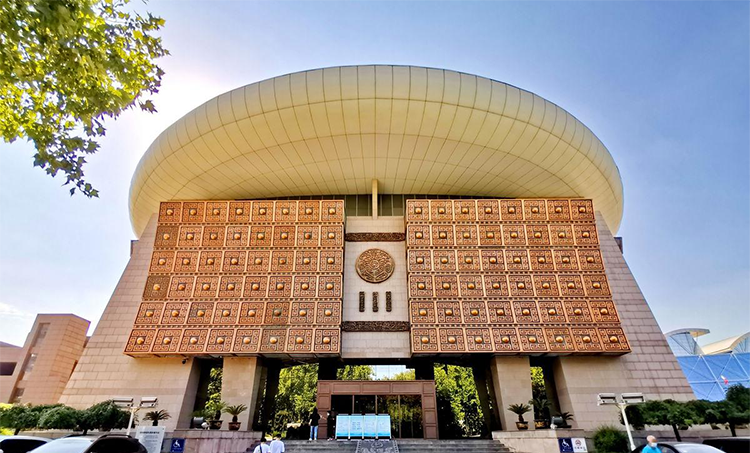Discover Shang and Zhou Bronze Treasures at Zhengzhou Museum
Standing before the new Zhengzhou Museum, the monumental bronze-square-ding–inspired building gleams like a ceremonial vessel slipped forward from the Shang dynasty. This 147,000-square-meter “cultural ark” is a first-class national museum that uses 60,000 artifacts to tell a three-dimensional history of Zhengzhou: from Neolithic pottery and Shang–Zhou bronzes to Han–Tang stone carving and Song–Yuan painting. Each object is a key to decoding eight millennia of Chinese civilization.
1. A Building, a Bronze Epic
Opened in 2021, the new Zhengzhou Museum is itself a contemporary work of art. Its exterior, modeled on the bronze fangding of the Shang era, pairs a truncated-pyramid geometry with a perforated metal skin—symbolically linking Zhengzhou’s role as a Shang capital to a modern architectural language of authority. Inside, a 30-meter-high skylight pours daylight into layered exhibition corridors, creating a tunnel-like sequence of time and space. As the cultural heart of Zhengzhou’s central district, the museum has been praised online as “the building that tells the best stories.”
2. Three Must-See Treasures
• Beast-Face Bronze Fangding (Shang dynasty)
This 58 cm-tall bronze ritual vessel contrasts a fierce taotie (beast-face) on its belly with delicate cloud-and-thunder patterns elsewhere. The mysterious cicada motifs on its legs hint at Shang beliefs in immortality. Archaeologists link this ding to ritual offerings to the Yellow River during the reign of King Wuding; its casting technique is often called a textbook example of Central Plains bronzework.
• White-Clothed Painted Pottery Basin (Yangshao culture)
An 8,000-year-old Neolithic treasure, its white surface is adorned with black-and-red arc bands and sun-and-moon motifs—some of China’s earliest astronomical records. Remarkably, its mineral pigments remain vivid after millennia.
• Seated Shakyamuni Buddha (Tang dynasty)
Carved from 1.8-meter hanbaiyu (white jade), this Buddha’s robe folds fall like flowing water and the face bears the classic Tang-era “downcast gaze” smile. Note the muscular guardian reliefs beneath the throne—stone carving techniques here predate similar Renaissance realism in Europe by nearly a thousand years.

3. Immersive Time Travel through the Shang Capital
The permanent “Ancient City Zhengzhou” exhibition functions as a time-travel guide. A 1:1 reconstructed Shang bronze workshop is paired with AR that lets visitors witness the dramatic moment of bronze pouring. The 360° dome theater condenses Zhengzhou’s evolution as one of China’s eight ancient capitals into a sweeping 10-minute film. On the second floor, the “Shang Civilization” special gallery hides interactive surprises: scan QR codes on bronzes to hear archaeologists narrate quirky insights, such as why the Simuwu ding remains unparalleled.
4. Practical Visitor Guide
• Best routes
– Quick tour (1.5 hours): Ground-floor central hall → Shang–Zhou Bronze Hall → Ancient City Zhengzhou → 3rd-floor stone carving gallery
– In-depth tour (4 hours): Add 2nd-floor ceramic highlights and 4th-floor painting & calligraphy halls, and join the free 15:00 guided talk (bilingual Chinese–English)
• Local insider tips
– Tuesday mornings are the least crowded—ideal for quiet viewing
– The west rooftop on the 4th floor is a prime photo spot for capturing the bronze-like architecture against the Zhengzhou skyline
– Don’t miss the B1 cultural shop: Shang–Zhou motif fridge magnets and “oracle-bone script” chocolate are popular souvenirs
• Practical info
– Opening hours: 09:00–17:00 (last entry 16:30); closed Mondays
– Admission: Free (reserve in advance via the official WeChat account; exchange passport for ticket on arrival)
– Transport: Metro Line 14, Aoti Center Station, Exit F; about an 8-minute walk
– Services: Free Wi‑Fi throughout the museum; English audio guide rental approximately ¥20 per device

5. Culture-Linked Day Trip Options
Link the museum with the Zhengzhou Art Museum (new building) and the Olympic Sports Center within a 3 km radius to form a cultural “golden triangle”: explore Shang–Zhou antiquities in the morning, enjoy contemporary Central Plains art in the afternoon, and end the day with local flavors—try a bowl of spicy Henan hu la tang at CCD Central Plaza’s “Meet Henan” restaurant.
When the sunset casts a golden hue on the bronze-inspired façade, you’ll understand why National Geographic named this region one of the Yellow River basin’s most rewarding 12-hour stops. Zhengzhou Museum builds a bridge across 8,000 years, and every visitor who crosses it takes home a piece of China’s living civilization. It’s time to open the first page of this bronze book.


